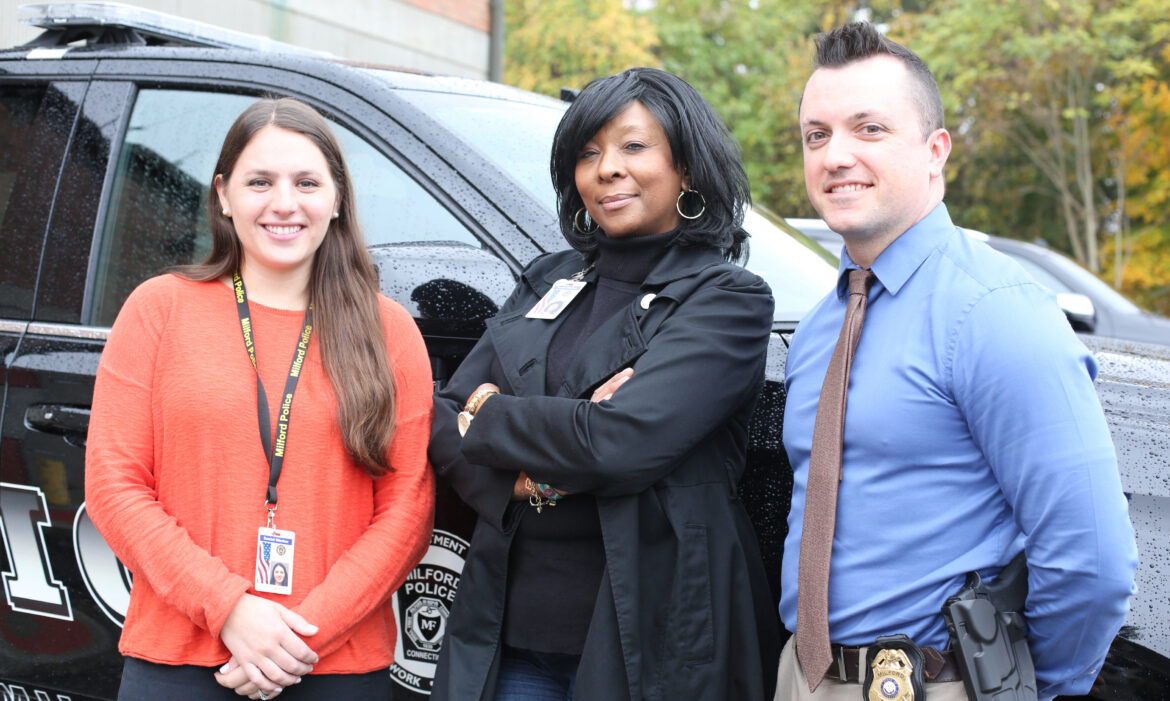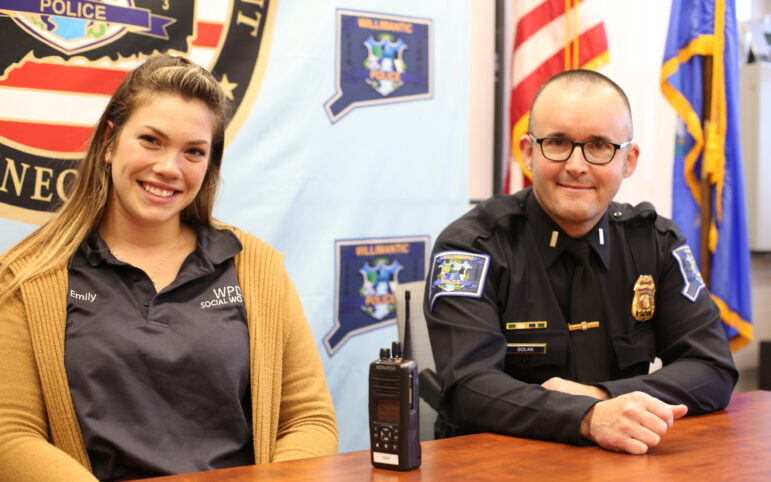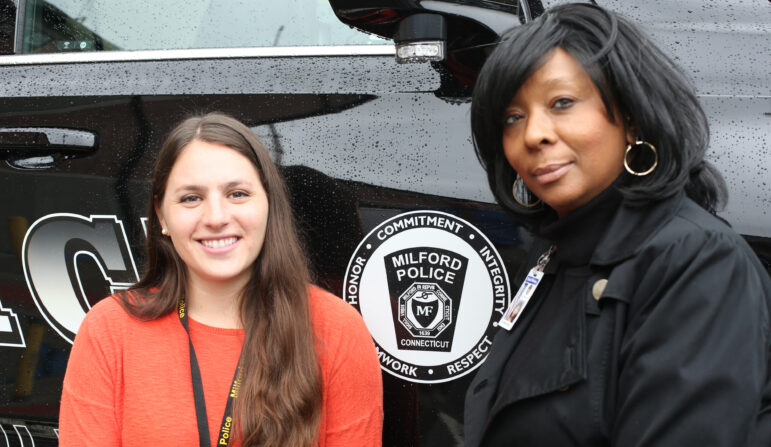By Carol Leonetti Dannhauser
RECOMMEND TWEET EMAIL PRINT MORE

Carol Leonetti Dannhauser Photo.
Caitlyn Cimmino and Tina Marie James, both Milford Police Department social workers, have responded to calls concerning domestic violence, breach of peace, larceny and other incidents. They are pictured with their supervisor Captain Garon DelMonte.
The 911 call came in from a parent whose son was threatening to kill himself. Typically, a police officer will race to a call like this, assess and stabilize the situation, and most likely request an ambulance to take the child away, leaving the family to pick up the pieces. In Milford earlier this year, that didn’t happen. Instead, the officer first summoned his colleague Caitlyn Cimmino, a licensed clinical social worker employed by the police department, and the pair dashed off together.
After the officer entered the home and ensured that the situation was safe, he invited Cimmino in to take over from there.
“It can feel a lot less intimidating to talk to a social worker,” said Cimmino, 27, who lives in Milford and has been working for the police department since January. The youth feared he was in trouble because police were called. “He said, ‘Is this thing going to be on my record forever?’ No, of course not. Just the sight of a police officer can frighten an individual, and fear can escalate a situation. It can feel more comfortable for them to talk to us.”
The visit ended not with the youth carted away by ambulance but with a connection via Cimmino to a therapist who could help and a promise by Cimmino to stay in touch with the family to make sure things were moving in the right direction.
When Cimmino was hired in January, the Milford Police Department became the second in the state, after Willimantic, to employ social workers in its ranks. Since the social workers were hired, the number of calls concerning mentally unstable members of the community has plunged, say officials from both departments.
Keeping The Troubled Out Of Trouble
The two departments are part of a small but powerful initiative called the Social Work and Law Enforcement Project, a statewide collaboration with a growing national reach whose aim is to help keep mentally unstable constituents out of trouble. Started by a former public defender social worker who became a college professor at Eastern Connecticut State University and the progressive police department down the road from her in Willimantic, SWLE embeds social work students as interns in police departments and trains them and police officers to work alongside each other.
The program has placed interns from Connecticut’s state universities, Sacred Heart University, the University of Saint Joseph and Fordham University, into the Willimantic, Milford, Middletown, Norwich and Stamford police departments over the past two years. Milford and Willimantic subsequently hired former interns early this year. Organizers believe it’s among the first training programs of its kind and a national model in the emerging field of police social work.
SWLE was born two months after the Connecticut Legislature passed the Police Accountability Bill in 2020 amid civil unrest following the murder of George Floyd by police during an arrest in Minneapolis. The bill mandated that police departments explore having social workers respond to calls and consider “employing, contracting with or otherwise engaging” them to assist police. The Connecticut State Police Union responded with a vote of no-confidence in Gov. Ned Lamont and the Department of Emergency Services and Public Protection after the bill’s passage.
But the pilot internship program began that fall in Willimantic and grew from there. Now, two years later, more and more police departments in Connecticut are enlisting social workers on site. The data, it seems, is turning skeptics into believers.
In their first six months as police department employees, Milford’s two police social workers, Cimmino and Tina Marie James, connected with 84 people suffering from mental distress, housing instability, addiction and more, who had called Milford police 683 times before the social workers were hired. Calls included help for domestic violence, larceny, psychological incidents, breach of peace, harassment and other incidents, according to Capt. Garon DelMonte, 36, a 15-year-veteran of the Milford Police Department who oversees the social workers.
Some people disconnected from reality would call 911 several times a day or at night. “It could be somebody experiencing paranoia or somebody delusional. Now, I can talk to Tina or Caitlin and say, ‘Hey, Johnny Smith called 14 times last night because he believed somebody was in his house. Will you talk to him?’” the captain said, adding that Milford police respond every time to every call, no matter how many times a person calls. “When we go somewhere and introduce a person that is not us, that is not capable of taking away somebody’s freedom, that will de-escalate the situation, maybe that person in crisis will say the police department is trying to help me here.”

Isabel Logan, a professor at Eastern Connecticut State University, is the founder of the Social Work and Law Enforcement Project.
A 2020 study by the Connecticut Sentencing Commission found that nearly 69% of people incarcerated in Connecticut have a history of mental health disorders.
Since the social workers were hired, DelMonte said, those same 84 people have accounted for 69 police calls. This tells him that the “implementation of social work services was successful to some degree in mitigating” the root causes of the initial crisis. “If we extrapolate these numbers out over the coming weeks, months, years, we should continue to see a great reduction of calls into the police department for individuals experiencing repetitive crisis.” He added, “Successful police work is the absence of problems, not numbers of problems.”
Who Will Call Tomorrow?
Social work and law enforcement run down the same highway in parallel lanes. Both are people-centered, communications-specialized vocations, DelMonte said. Police “go out and do all these great things … but who will call that person in crisis tomorrow? As much as we want to or try to, we just don’t have the time.” The social workers, he said, “provide the follow-up that is lacking in a law enforcement response.”
According to DelMonte, a social worker could have been helpful “hundreds of times” during his tenure, particularly in the detective bureau. “You think about the trauma of a sexual assault victim, or a juvenile, or a missing person. Almost every single one of those can benefit from a social worker.”
Milford’s chief, Keith Mello, chairs the state’s Police Officer Standards and Training Council and attended the state task force meetings on police accountability. After the bill was passed, there was a mandate but no template for exploring police social work. Mello learned about the fledgling program in Willimantic from its founder, Isabel Logan, Ed.D, LCSW, and signed on in the fall of 2021.
Logan, 48, had worked in the court system for 20 years, first as a social worker in the public defender’s office in New Haven, then at Hartford juvenile court.
“I was always driven by social justice, especially the intersection between social work and law,” said Logan, a Brooklyn native who grew up in the North End of Hartford.
She spent most of her career trying to prevent juveniles who had already been arrested from getting deeper into trouble, whether by setting up treatment programs for them to be released to, sending them to community programs or meeting with family members. “Anything possible to help clients not be in the system.”
Logan pursued doctoral studies at the University of Hartford at night while working by day. When a position opened at Eastern, she applied. She hoped to develop a prevention program. Just two years into her tenure, Steven Barrier, a Stamford man who suffered from various mental health disorders, died while in police custody in 2019. About seven months later, Floyd was killed, leading to calls nationwide and in Connecticut for police reform.
Spelling It Out
Logan felt she was in a unique position to do something about it. “I was interested in setting students up to work with police. I thought maybe we could help prevent people from getting arrested in the first place.” She had her students research police social work initiatives nationwide to help develop a framework. “We carefully carved out everything. Having a forensic legal background, I said let’s make sure we dot our i’s and cross our t’s. We documented everything,” she said.
Logan found a willing partner for her program less than a mile away. Lt. Matthew Solak, 45, was an 18-year veteran of the Willimantic Police Department and an Eastern alumnus. A proponent of community policing, he believed that many crimes would be prevented if constituents with mental health needs had better access to community services. Indeed, about 10% of service calls to police departments stem from someone with a severe mental illness, according to U.S. Department of Justice figures. “Law enforcement cannot arrest its way out of the problems mental illness creates in a community,” the DOJ report “Community Oriented Policing Services” concluded, “but can only address them by and through collective community effort.”
Solak lamented that police didn’t have resources to follow up with clients after a crisis. With the blessing of police Chief Paul Hussey, the Willimantic department agreed to pilot the internship program.
“You can’t just take a social worker and put them in a police car and expect it to work,” Solak said. “You have to identify someone who is interested in the work and in working seamlessly alongside your officers. That training component is really key. You have interns in emergency rooms, interns in hospitals, interns in schools. This is an extension of that.”
Logan and Solak created the first police social work academy in the country where social workers and police from the same department train together at the Connecticut Police Academy in Meriden.

Carol Leonetti Dannhauser Photo.
Social worker Emily Constantino was the first hired by the Willimantic Police Department. She is pictured here with her supervisor Lieutenant Matthew Solak.
Emily Constantino, Logan’s student for four years, was the first student placed. She now works full-time as a Willimantic Police Department employee. Constantino, of Coventry, said her family was skeptical when they learned of her placement. “In the summer of 2020, there were a lot of strong opinions about the police department,” she said. Beyond watching the TV shows “Law and Order” and “Brooklyn 99,” she didn’t know anything about police work and had never set foot in a police station, she said. “I remember thinking I can either watch what’s happening or go out into the community and try to do something. I felt like this was a really heavy responsibility.”
But after interning for 400 hours during her senior year at Eastern and 600 hours more as a graduate student at the University of Saint Joseph in Hartford, she was astounded at how many calls police departments receive that have nothing to do with criminal activity but with social issues concerning people in crisis. When the offer came to work full-time as a police social worker for the department, she signed on.
Word of their assistance is spreading throughout the community. Constantino arrived at the department one morning to find a woman sobbing in the lobby. The woman worked in town but had gone to the police department instead to escape her husband, who was abusing her and their children. Constantino connected the woman with the resources she’d need to escape, and her police officer partners took care of actions against the husband.
Making Things Different
Tina Marie James, 57, was studying for her master’s degree in social work at Sacred Heart University and working 12-hour weekend shifts in the psychiatric department at St. Vincent’s Medical Center in Bridgeport when Logan called about an internship in Milford in the fall of 2021. “I wanted to work in the community, but I’d never thought about the police department,” James said.
Her experience with police had been limited to one dreadful episode. When she was a youngster, James’s favorite uncle, who owned a candy store at Marina Village in Bridgeport, was robbed at gunpoint by four thieves. Her uncle had a gun, killed one thief, and maimed another. He was incarcerated for seven years. “All he’d wanted to do was be there in the neighborhood. Knowing the hurt that my mother felt and my cousins having to deal with the loss of their father, I realized I could assist in the process of making things different.”
Her friends weren’t so sure. “They were like, let’s address the elephant in the room.’ I’m an African American, middle-aged woman in a predominately white-employed police department. We know a lot of news with police officers, and it’s negative. It’s put a scarlet letter on the police department,” James said. “I’ve had one person say social workers shouldn’t be here. They think the police department should be defunded. But I think that right now, we as humans need to be more supportive and helpful. Social work is 80% listening. We have gotten away from that.”

Carol Leonetti Dannhauser Photo.
In Milford, social workers Caitlyn Cimmino and Tina Marie James respond to calls about housing insecurity, addiction and more.
James was hired full-time in February. She and Cimmino share space with the force’s crime prevention officers. They all work cooperatively with the city’s Human Services Community Outreach Workers and the Beth-El Center, a homeless shelter and soup kitchen.
While Milford and Willimantic are the only police departments in Connecticut that employ social workers, other departments maintain robust relationships with social workers. In Waterbury and Middletown, for example, police work hand-in-hand with embedded social workers employed by the Connecticut Department of Mental Health and Addiction Services, which fields more than a dozen crisis intervention teams, some of whom operate out of police departments.
In October, Stamford police embedded a second social worker from the nonprofit group Recovery Network of Programs into their department. Based on Stamford’s success, Norwalk embedded its first social worker from RNP the same month. In her first 17 days on the job, that clinician, Alexandra Fitzner, followed up on 25 referrals from patrol officers.
In New Haven, an “unarmed emergency response team” stands ready to help police respond to 911 calls involving mental illness, substance abuse or homelessness. Elm City COMPASS, or Compassionate Allies Serving Our Streets, started in November and is funded with a $2 million federal grant. Hartford’s civilian response program, the Hartford Emergency Assistance Response Team, began last spring. HEARTeam responders include a mobile unit from the Capital Region Mental Health Center.
Fairfield police hope to become the third department to hire a full-time social worker. The job description includes everything from helping residents access mental health and addiction services to decreasing recidivism by “repeat consumers” to minimizing use-of-force incidents by officers.
A study by the University of Connecticut Institute for Municipal and Regional Policy found that 31% of people on whom police used force in 2019 and 2020 were reported to be “emotionally disturbed.”
Lt. Solak of Willimantic said his mental health unit is “serving citizens in a much more involved way. Having mental health as part of the police department is a sea change in law enforcement. It’s been fantastic.”
SUPPORT OUR WORK
The Conn. Health I-Team is dedicated to producing original, responsible, in-depth journalism on key issues of health and safety that affect our readers, and helping them make informed health care choices. As a nonprofit, we rely on donations to help fund our work.Donate Now

